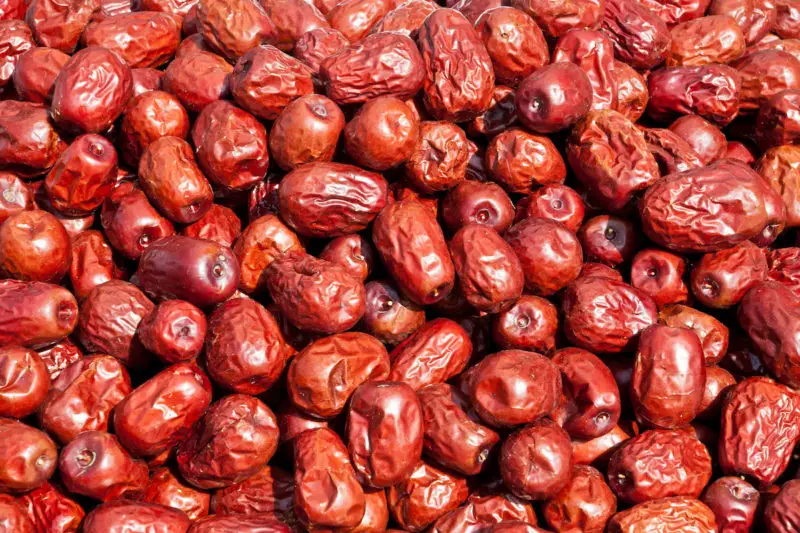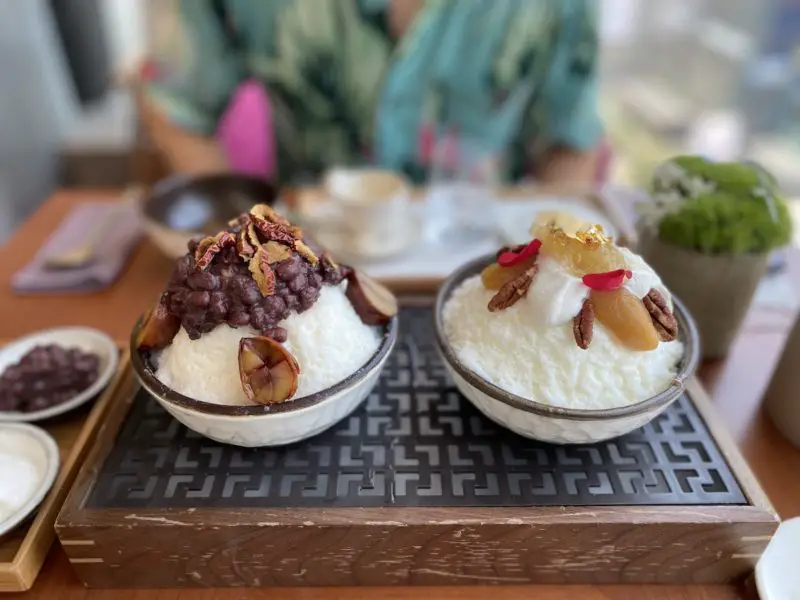This post may contain affiliate links. Please read my disclosure for details at the bottom of this page. As an Amazon Associate, I earn from qualifying purchases on this article about jujubes in Korean cooking. We hope you enjoy learning about daechu.
In South Korea, people use different ingredients besides sugar to naturally sweeten foods. Some of these ingredients include Asian pears, green plum syrup, honey, and more. Another one of these foods that naturally sweetens food is the jujube (daechu)! This small, date-like fruit adds a hint of sweetness as well as tartness to a dish.
Here, we discuss this ingredient and how it is used in Korean cuisine!
What Are Jujubes (Daechu)?
The jujube plant, otherwise known as jujuba, red date, Chinese date, and Chinese jujube, is a species scientifically known as Ziziphus jujuba in the Ziziphus genus. Thought to be native to Southern Asia, historians and botanists believe the plant’s origin starts between Lebanon, northern India, and Southern/Central China.
During July and August, the fruits of the jujube plant ripen. People across Asia and Europe eat these fruits both fresh and dried! Here we will learn about how people use these fruits in Korean cooking!
Note: The English term ‘jujube’ potentially comes from the French word ‘jujube’ or medieval Latin ‘jujuba.’
Daechu In Korean Cooking:
In the Korean language, fresh jujubes are known as ‘daechu’ (대추). In South Korea, people typically use dried daechu rather than fresh ones when cooking in their kitchens. You will often see two types of this dried fruit in Korean cuisine.
- First, you might see jujubes dried similarly to raisins (dehydrated grapes). This style of dehydrating and preserving still keeps some of the moisture in the fruit. For the most part, when using jujubes as a cooking ingredient in South Korea, people use this variety. These are known as ‘mallin daechu’ (말린 대추). You can order these online!
- Second, you can find completely dried jujubes. These are crunchy because they remove all of the moisture from the fruit. Often, people use this style of jujube in South Korea as an edible garnish. These are known as ‘ daechu chip’ (대추칩). You can also order these online!
Daechu as a Cooking Ingredient (Mallin Daechu):
Below, we list a few ways people use these dried fruits as an ingredient in cooking. Remember, people use semi-dried raisin-like jujubes.
- Samgyetang (삼계탕): In English, we translate this clear Korean soup to ‘ginseng chicken soup.’ To make this summer dish, people in Korea stuff a small chicken with rice, ginseng, and jujubes before boiling it until the meat falls off the bone. The jujubes add a sweet flavor to the dish.
- Daechu-Cha (대추차): In English, people refer to this Korean drink as ‘jujube tea.’ In South Korea, people make this tea using two methods. One method involves boiling dried jujubes in water, while the other method involves boiled preserved jujubes in water.

Daechu as a Garnish (Daechu Chip)
Next, we list a few examples of how people use dried fruits as a garnish in Korea:
- Patbingsu (팥빙수): In English, we translate this sweet dish to ‘red bean Korean shaved ice.’ Often, people add dried jujube chips to the top of this traditional Korean dessert as an edible garnish!
- Hobakjuk (호박죽): We translate this Korean thick soup as ‘pumpkin soup.’ During the fall and winter, people commonly eat this pumpkin-based soup topped with dried jujube chips.

Jujube Frequently Asked Questions:
Now that we learned about the jujubes (both fresh and dried) in Korean cooking, we want to answer some questions you may have about this ingredient! If we do not answer your question, feel free to leave a comment in the section below or email us at [email protected].
Where Can I Buy Jujubes?
In the United States, it is very difficult to find completely fresh jujube fruits. Instead, you can find both types of dried jujubes in well-stocked specialty stores like Whole Foods. You can also order them online as well as buy them in Asian grocery stores!
Where to Buy Korean Ingredients Online?
Nowadays, there are many online options to choose from to order Korean food online. These websites are not limited to but include:
- Amazon
- H-mart
- Hanpoom
- Wooltari
How Do I Properly Store This Ingredient?
Typically, you can reseal the bags and place them in a cool, dark location (like a kitchen pantry). You can also store them in the refrigerator.
Always check the packaging before placing an item in the pantry to make sure it doesn’t need to be refrigerated.
How Long Does Daechu Last?
I recommend eating fresh jujubes within 7-10 days. You can store dried jujubes for up to one year from your purchase date.
We Hope You Enjoyed Learning About Jujubes In Korean Cooking!
In the end, we hope you enjoyed learning about jujubes in Korean cooking! If so, let us know in the comment section!
If you would like to read more about cooking, you can find further recipes on our blog. We listed some of our favorite Carving A Journey Korean recipes below! For reference, many recipes are influenced by our blended Korean and Southern heritage.
Korean Ingredient Articles:
- Chrysanthemum Greens in Korean Cooking (Ssukgat)
- Dandelion Greens in Korean Cooking (Mindeulle)
- Korean Fermented Salted Shrimp (Saeujot)
- What Is a Korean Melon? (Chamoe)
- Black Sesame Seeds in Korean Cooking (Heukimja)
Further Carving A Journey Recipes:
- Mango Bingsu (Korean Shaved Ice)
- Peach Sweet Tea and Bourbon Cocktail
- Strawberry Matcha Latte
- Korean Banana Milk
- Korean Strawberry Milk
- Soju Cocktail: Soju Caipirinha
- Iced Burnt Brown Sugar Latte
- Classic Southern Lemonade
If you have any questions or comments, you can also email us at [email protected].
And, finally, we would love to hear from you through our social media as well! You can follow us at @carvingajourney on Instagram, Facebook, and Pinterest. I also started a vlog Youtube channel! Or, if you would like more articles like these, you can subscribe to our blog by joining our mailing list. Let us know if you try using daechu when cooking! Thank you so much for stopping by!
Carving A Journey is a participant in the Amazon Services LLC Associates Program, an affiliate advertising program designed to provide a means for sites to earn advertising fees by advertising and linking to Amazon.com. Although we may earn commissions for our endorsement, recommendation, testimonial, and/or link to any products or services from this website, these opinions are my own and I fully support these products.

